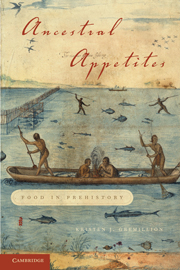2 - Beginnings
Published online by Cambridge University Press: 05 June 2012
Summary
In a very real sense our intellect, interests, emotions, and basic social life – all are evolutionary products of the success of the hunting adaptation.
Washburn and Lancaster, “The Evolution of Hunting”Gathering food was an early, critical invention and an important step in the divergence of the hominid line.
Tanner and Zihlman, “Women in Evolution – Part I: Innovation and Selection in Human Origins”Some five million years separate the elaborate traditions of haute cuisine from the opportunistic omnivory of the first hominins (our earliest ancestors who walked upright). This may seem like a long time, but in the context of the history of life on Earth, a million years is the blink of an eye. For complex animals that live long and mature slowly, years pass between the reproductive events that register the effects of natural selection. Genetic inheritance alone cannot account for the great diversity of human foodways observed today, although it goes a long way toward explaining why we are so adept at dietary improvisation. This tendency to innovate began to shape human diet long ago, in a world where the ability to explore new food sources had life-or-death consequences. But innovation alone cannot build traditions, accumulated bodies of knowledge about what and how to eat. Cultural traditions depend on cognitive capacities that allow people to share complex information.
- Type
- Chapter
- Information
- Ancestral AppetitesFood in Prehistory, pp. 12 - 30Publisher: Cambridge University PressPrint publication year: 2011

